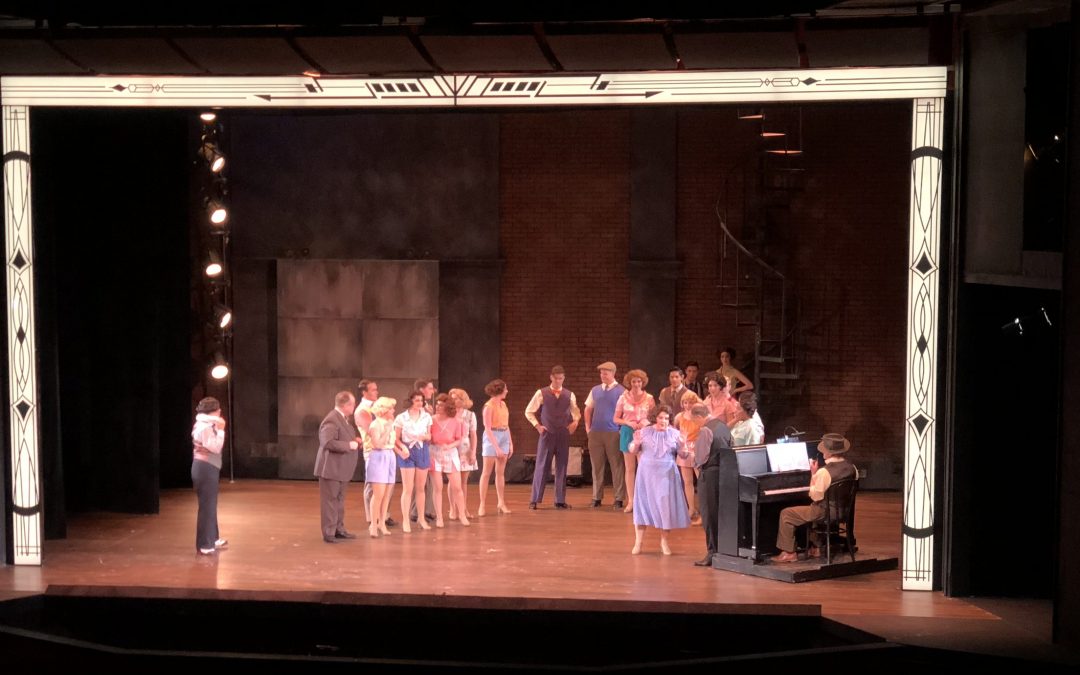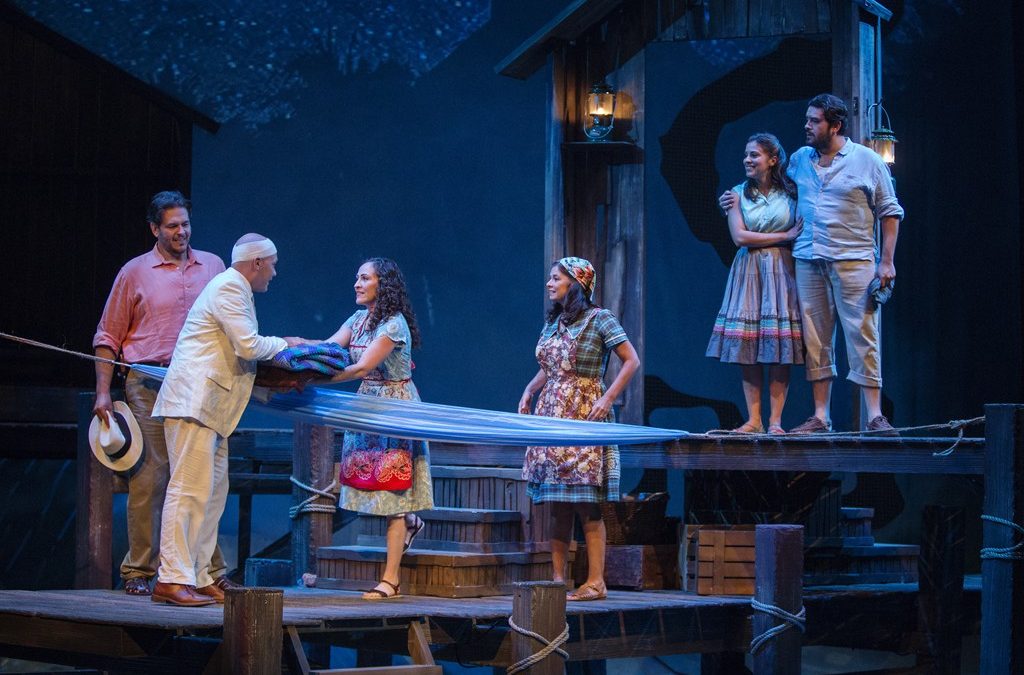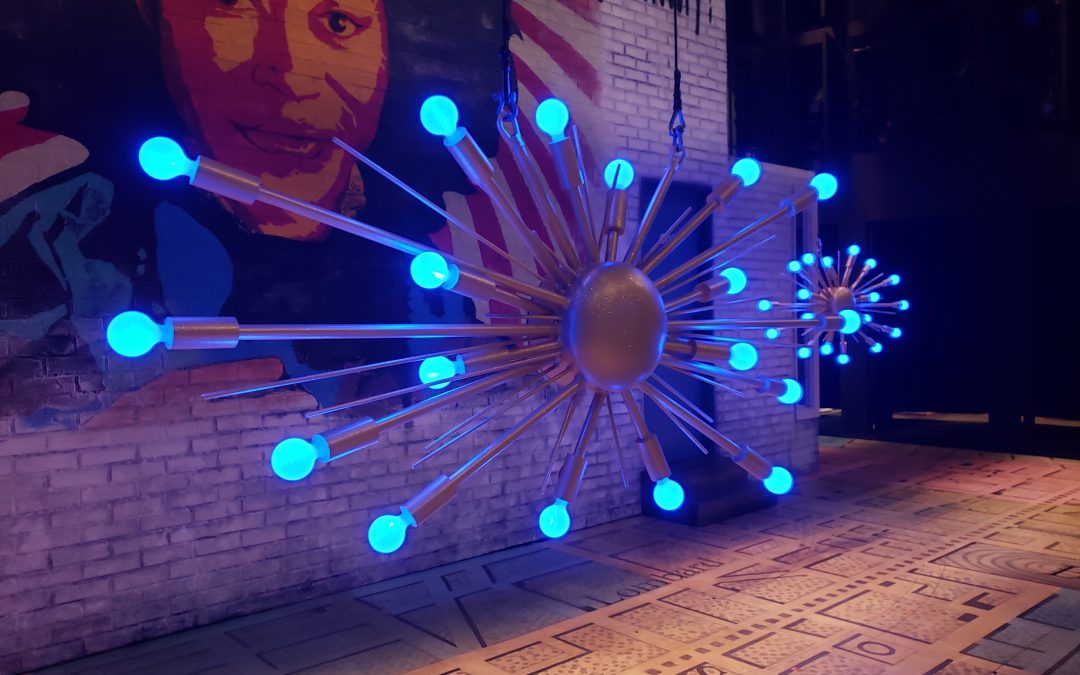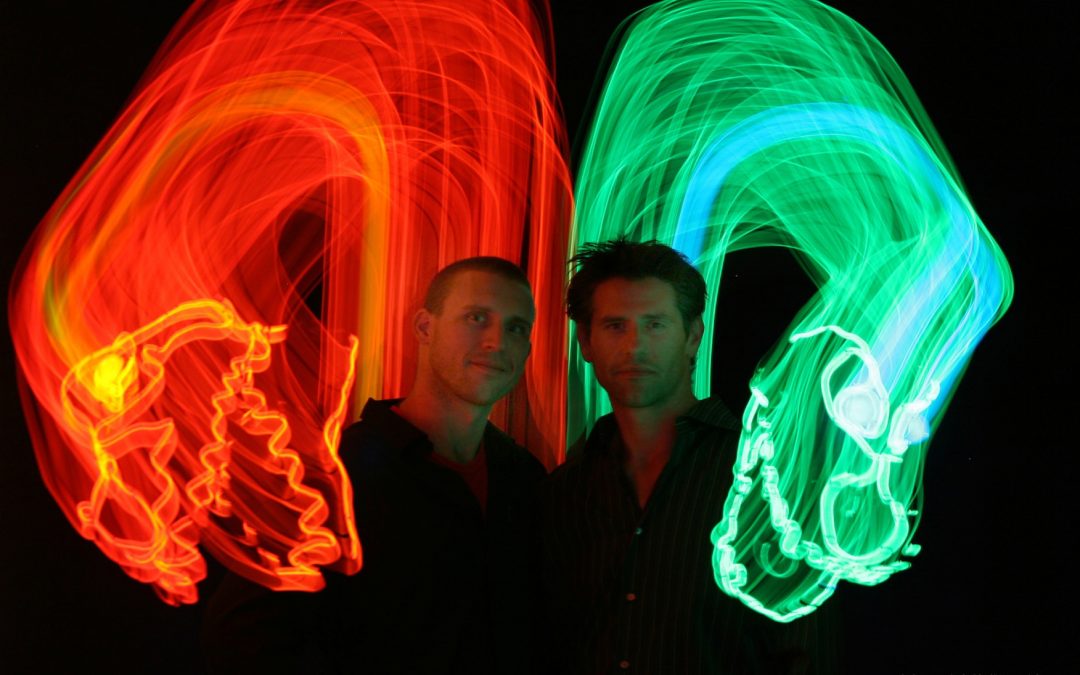
by boss | Jul 17, 2019
In Europe, Robbie Williams is a legend; he regularly fills stadiums and his productions are some of the most anticipated on the continent. One of his dreams was to do a Vegas show, and to make every detail of Williams’ show perfect, Production and Lighting Designer Sean Burke, principal at Holes in the Dark, needed reliable wireless DMX technology. “When the wireless stuff came up, I did a bit of research on it, looked around, and saw that Baz [Halpin, of Silent House Productions] used RC4 Wireless products on the last Katy Perry tour. I know the crew chief, and he said they didn’t have any problems with it,” confides Burke. That was enough for him to entrust RC4 Wireless with the job for Williams’ “Live in Las Vegas” show. Matt Bakken, the Master Electrician on the show, adds: “When a lot of people in the touring industry use wireless, they use equipment from RC4; to me, if your wireless is working in a stadium with 25,000 plus people with cell phones, that’s good enough for me.”
For the Williams’ production, the team built their system around an RC4Magic Series 3 DMXio-HG Transceiver with External Antenna; working along with the DMXio are six RC4Magic Series 3 DMX4dim 4-Channel Wireless Dimmers. “Addressing was easy and very straight forward; pairing the receivers with the transceivers was simple as well. The system was exactly what I wanted and it just worked,” reports Bakken.
There are several props using the RC4 Wireless DMX4dims; specifically, two giant Martini glasses and four stylized box frames, called Gogo frames. “The GoGo frames are open aluminum frames that the dancers push around and dance inside. The Gogo frames and the Martini glasses have wireless receivers on board and battery packs, so they are completely wireless,” explains Burke. In terms of batteries, Bakken adds, “The batteries are lasting pretty much forever on them, and sometimes they forget to plug them in to charge them.” Both the Gogo frames and the Martini glasses were manufactured by ShowFX, who also handled the Katy Perry props.
“After working in the professional theatre world for a few years, I founded RC4 in 1991,” says James David Smith, also the Chief Product Developer. “Our DMX4dim wireless dimmers are the pinnacle of design, and can control LEDs, halogen lamps, position servo motors, ring telephones, and more. The RC4 ColorMatch feature lets you color-correct LEDs from different manufacturers to deliver the same color palette across all props and scenery.”
It’s no secret that Las Vegas is a busy wireless environment. “We have several wireless systems running concurrently; at no point did I see any signal degradation or interference,” says Bakken. Placement of the transceiver is also important. “I try to mitigate any potential issues by putting the transceiver right down by the proscenium on the stage, so there would be no problems. And there weren’t,” Bakken adds.
The ability to punch through crowded wireless areas is a fundamental part of all RC4 Wireless products. “The entire RC4Magic Series 3 system, starting with the DMXio-HG transceiver, uses proprietary wireless technology unlike any other,” explains Smith. “It consumes just 1/15th of the 2.4GHz radio band and punches through the noise like nothing else.”
There are many in the industry that are cautious of wireless dimming and DMX. “I know a lot of people who are incredibly wary of wireless because they have been burned in the past. When you’re using it, your wireless must work,” states Bakken. The RC4 products on Williams’ show proved their worth night after night. Bakken says: “RC4 gear works well and that’s all I can ask for. If you haven’t used it, you should give it a shot.”
Robbie Williams concluded his stint in Vegas on July 6th; however, the U.K. press reports that he’s close to inking a six figure residency deal there.

by boss | Jun 18, 2019
Production/Lighting Designer Jeremy Allen Fisher is a veteran RC4 Wireless user. “I started working with RC4 products in 2009 when I worked for the Santa Fe Opera for a summer, and then I started working with them heavily in 2011 when I started working for Theatre Memphis. I started with Series 2 and now I’m on Series 3,” he explains. Today, Fisher is at the Tennessee Shakespeare Company and is on the 2.4GHz line of products. Fisher continues: “At Theater Memphis, I had a two channel and two four channel dimmers, DMXpix units, four channel high power dimmer and two DMXio transceivers. Now I have one of the 6 channel DMX6dims, one 6 channel high power dimmer [a DMX6dim-500], one DMXpix and one DMXio transceiver.”
Fisher’s most interesting wireless project took place at Theatre Memphis. He picks up the story: “We made a low rez video wall using two RC4 Wireless DMXpix. I made these 1’ by 4’ wooden boxes; each one had eight rows of WS2812 LED tape in them. I made 15 of those boxes that all connected together to make a proscenium arch all the way around. Using the DMXpix to drive them, I was able to turn that into a low rez video wall and then run animation clips and video clips through the Ion console to get my content onto that to make color effects and things, rather than programming them individually and trying to do it that way.”
The modular system was decorative as well. “The boxes were covered with a plastic film that had images printed on it to give to an Art Deco feel and the boxes lined our proscenium. This film was very cheap and a local sign company printed it for us. It’s typically used in back lit LED signs, which made for nice smooth blending without much loss of output. This system was designed to come apart and rearrange, from show to show, just using different covers. So far, we have used this in 2 other shows. Each box has its own power supply and making it usable and stand alone in any configuration. The total cost — not including the DMXpix — was about $1200 to $1500.” The LED wall was created for their performance of 42nd Street in 2018. “Since we created them, we have used them in a variety of different orientations, including in ‘Hairspray’,” Fisher adds.
Fisher’s RC4 wireless units did more than dim without wires; they saved time. “Over my years at Theatre Memphis, I made a stock of different practicals; I just popped an RC4 unit into them and the unit was good to go. They were all quick rigs with Anderson connectors; all I would have to do is pop a battery in, put and RC4 dimmer on it and away it went. I put in time on the front on end, lamp in room, but when people asked for something like a lamp in the middle of the room, I already had choices for them. I was able to save myself time by having all these tools in my arsenal that I could pull out, pop in an RC4 dimmer into it and then away it went,” he explains.
The RC4 Wireless units are a newer addition to the Tennessee Shakespeare Company. “I only bought them last season, so I haven’t done much with them here yet; I did something simple with some MR16s. It wasn’t anything too fantastically amazing. There was a prop in the middle of the room that we couldn’t get cables to, so I made it wireless. It was a stone altar for Macbeth, and in the stone altar there were reservoirs of blood and the reservoirs were lit with MR16s to help them glow,” the designer notes.
As a veteran RC4 user, Fisher has some wisdom to pass along. “I think a lot of people think wireless unreliable. My RC4 equipment has never given me problems, and when there has been an issue, it’s never been the wireless portion or the product, it’s because I wired something wrong,” he explains. There is also the time factor. “I don’t think people know how much time these products can save you in terms of wiring. When you first look at wireless dimming, it can seem daunting, but you break it down, it can save a lot of time,” Fisher adds.
When there is an issue, RC4’s customer service is based in the US, and ready to help users find solutions. Fisher concludes, “There is nothing like the RC4 Wireless customer service in the entire industry. Nothing.”

by boss | May 23, 2019
Everyone’s wireless dimming and DMX journey is different. Kat Seaton, Lighting and Projection Supervisor at The Arizona Theatre Company tells her story:
I was working as an Electrician at Scottsdale Community College in 2013 when we had a production that needed wireless dimming; we went with RC4 Wireless. When we got the first products in the theatre, the directors were so excited they wanted to use it on every show. It’s a portable dimmer you can place in the middle of the stage. At the time, we purchased a DMXio transceiver and three DMX2dim wireless dimmers.
RC4 Series 2 products—which are oldies but goodies have been a big part of my next job at The Arizona Theatre Company. I work with a lot of young technicians, that are unfamiliar with these dimmers, and all that they can do. Often believing that if it is older technology that is not working, it is broken rather than learning about it. I work in theater, so I don’t have the budget of someone like Katy Perry or Pink so can’t get something brand new. We have to find ways to make things work, which is why I’m still using RC4 Series 2 products for the past 5 years.
Typically in my world, when there are problems with these dimmers, it’s operator error. When unexpected problems happen, people shouldn’t be afraid to call RC4’s customer service. When I’ve called, it’s been a fantastic experience. At one point when I called, I ended up talking to Jim [James D. Smith] which was kind of mind blowing. You don’t expect to talk to the developer when you call tech support. They are literally the people that have designed it and built it.
Our company performs in two different venues—The Temple of Music and Art and the Herberger Theater Center—and we do every production twice. We do it in Tucson first at the Temple of Music and Art, and then in Phoenix at the Herberger Theater Center. While the production is going on in Phoenix, we begin work on the upcoming production in Tucson. Consequently, we have double of almost everything. When we have a show that needs wireless, it’s typically for moving scenery pieces and we’re trying to reduce cable traffic or for props. We’ve used it on a number of shows over the years, including our recent productions of ‘Music Man’ and ‘American Mariachi’. RC4 gear isn’t sketchy or unreliable; in fact, it ended up being an incredibly versatile, handy tool for our theaters.

by boss | Apr 11, 2019
The Oregon Shakespeare Festival [OSF] has been delighting audiences since 1935. Their productions are wildly varied; one constant is the fact that when they need wireless dimming and DMX, they turn to products from RC4 Wireless. “I really am happy with our RC4 products. We’re not having drop out problems, and they handle power really well,” notes Michael K. Maag, Resident Lighting Designer, Oregon Shakespeare Festival. For their current performances of Shakespeare’s As You Like It and Hairspray, Maag and his crew, led by Mac Vaughey are using 8 RC4Magic 2.4GHz DMX2dim wireless dimmers. In As You Like It, “There are 8 lanterns; they’re a columnar lantern that are approximately 18” high by 6” in diameter, with a laser cut shade to match the scenic design,” says Maag. Inside each of the lanterns are three theatrical dimmable flicker candles. “We have a DMX2dim in each lantern; at the end of the show the actors move out into the house, surrounding the audience, and spin the lanterns in their yokes. At the final lines of the play, starting with ‘all the world’s a stage,’ the audience is surrounded by spinning lanterns throwing slowly fading firefly light, and it creates a great emotional moment,” he notes. As for the DMX2dims, Maag reports: “They’re working great; they have beautiful dimming curves and they’re very, very solid in terms of communication.” For Hairspray, the properties and lighting department have created two 4’6” by 3‘ tall ‘sputnik’ chandeliers. Maag explains: “There is extremely limited space in which to fly the chandeliers, so we made them only 8” deep. Nina Ball, Scenic Designer, modeled angles on the spokes to give the illusion of three dimensionality even though they are essentially flat.” Other constraints made it more practical to power these fixtures with batteries. “We put individual RGB LEDs with 3d printed bulbs at the end of the spokes,” Maag reports. For wireless control of the chandeliers, OSF is using the RC4 DMXpix, a pixel driver that can be used to control two separate pixel strings. “The DMXpix gives us control over each RGB LED in each bulb. We wanted to give our Lighting Designer Jason Lynch the flexibility to chase the chandeliers along with the beat in the Corny Collins sections of Hairspray.” In terms of fabrication, Maag says: “The chandeliers will make everyone laugh; they’re a rat’s nest of wires, all coming back to DMXpix. There’s a lot of wires… a lot of individual wires” The DMXpix was first used at the Oregon Shakespeare Festival last year on a production of Snow in Midsummer. “Costume Designer Helen Huang asked us to create two giant 9’ tall demon puppets from Chinese mythology: Horse Face and Ox Head guide spirits to the underworld. There were about 160 RGBW pixels on each puppet. That’s beyond what we could control in one universe, but the DMXpix allowed us to control them without using another universe. The DMXpix is really convenient for mapping fewer DMX channels to control more pixels,” says Maag. “In fact, we used only 16 DMX Channels per puppet, giving us room for other wireless effects in that universe. Yet our Lighting Designer Jane Cox had all the flexibility she needed to create the creepy flicking demon light.” Maag and his crew have been creating magic with RC4 products for the past ten years. “Having reliable gear from RC4 on stage makes production management happy and makes the directors happy. You don’t find yourself working for very long if you recommend cheap, unreliable gear. I know the products from RC4 are going to work and they solve so many problems in a live theatrical environment,” he says. To program the RC4 gear, “I’m using the using the [RC4 Wireless] XStick [configuration dongle] with the RC4 Commander software and that makes setting all the parameters much more intuitive for me. For my mind, I like seeing it graphically laid out on the computer, using the Commander software rather than doing it from the console,” notes Maag. In terms of technical support, Maag says: “RC4 has fantastic service. Whenever I call and I have a question they are patient and walk me through my mistakes in a gracious way. The guys are really great in terms of helping me understand where the problem is and how to fix it. Every time it’s something silly I’ve done.” The RC4 Wireless customer service team is based in North Carolina, and all products are fabricated in that state as well. “I don’t have to call outside the US; I don’t speak other languages, so my ability to get quality customer support from China, for example, is non-existent. I also consciously support companies that are in the US that share my values. In the end, customer service is the main reason to use RC4,” Maag remarks. Wireless dimming—and RC4 Wireless—is also part of the future at the Oregon Shakespeare Festival. “On MacBeth, we’re going to use some DMX4dim500s. There are these 12’ tall light towers, at the base of which will be a bunch of 12-volt LED tape for up lighting through the Plexi base. At the top will be a 36-volt SORAA LED light engine that produces a 4000k 10-degree bright beam; the DMX4dim allows us to easily use multiple voltages in one dimmer module. We can have both 12-volt LED tape and the 36-volt light engine on the same RC4 product, which makes my life easier,” Maag concludes.

by boss | Feb 15, 2019
When New Orleans-based Lightwire Theater premiered their groundbreaking combination of dance, EL wire and wireless dimming on America’s Got Talent, the judges had nothing but praise. Sharon Osborne said: “That was spectacular in every sense of the word.” Howie Mandel had his own brand of praise: “Three letters. W. O. W. Just wow.” And finally, the inimitable Howard Stern explained, “It’s electronic, it’s lights, it’s dance and it’s a great show.”
The firm, founded by performers Ian Carney and Corbin Popp, produces five shows that tour worldwide: Dino-Light, The Ugly Duckling, Moon Mouse: A Space Odyssey, A Very Electric Christmas and The Show. All the productions are centered around elaborate EL wire costumes and, of course, dance. “For us, high technology is not the show, the high technology expands the show and moves the story forward,” states Carney.
However, technology is an integral part of the production, and that means a different set of concerns as opposed to conventional theater and dance. “Being in theater, so much depends on everything working,” says Carney.
Due to the nature of the show, it was natural for the company to venture into the wireless realm. Their first purchase was a key chain style remote dimmer that cost about $30. “That began our journey into the world of wireless,” Carney confides.
Their wireless journey continued as their productions became more complex. Lightwire needed more wireless for the costumes, as well as for the set pieces, props, and lasers. Carney continues: “A long time ago, we told the team at RC4 Wireless that we were looking for not just a vendor, but we’re looking for a partner, and wanted to know if they were willing to be that partner? We tour full year and tour internationally, but we’re not a Cirque company. When we call you on the phone, will you be willing to answer?” The reply from RC4 was a resounding “Yes.” Carney adds: “For a relatively small investment, you are in a very solid world with RC4; they have great tech support and are an organization who is going to be a partner with you. The quality, the service, and the flexibility are there for a company like ours. RC4 Wireless is not just for the big businesses.”
For their various productions, “We use RC4Magic Series 3 transceivers with four and two-channel dimmers; we wire into the drive system that is necessary for EL wire. The characters turn themselves on and off with sliders on their costumes,” Carney explains. He also uses them for the EL wire infused sets. “I can plug the DMX cable into the set, and I can program the RC4 Wireless box with my slider board for that show. It’s as simple as that. And when I’m not doing that show, I can use the boxes on one of our other shows,” he says.
Lightwire Theater also uses the RC4 gear with their lasers. Carney notes: “I can change the cues, program the board, and, using the RC4Magic two channel receiver at the laser, I can actuate the laser cues from backstage.”
Carney and the Lightwire team are using the RC4 Wireless dimmers and transceivers in a very straightforward manner. “The products are as low tech as you want or as high tech. I’m not even scratching the surface of what RC4 products can do and it’s changed the way we can make shows.”
All the Lightwire Theater productions travel the world, from Canada to Abu Dhabi, and everywhere in between, and the wireless transceivers/dimmers are thrust into less than ideal conditions. Carney says: “All the RC4 Wireless units are being stored in non-climate controlled environments, on things like ships going to China. If they’re sitting in a trailer and it’s freezing cold or it’s really hot, it doesn’t matter; we’ve never had an issue.”
Lightwire Theater has a bright future in front of them, and it includes RC4 Wireless. “We’re premiering a new show next year, and we want to learn more about what we can do with RC4’s products,” Carney concludes.




